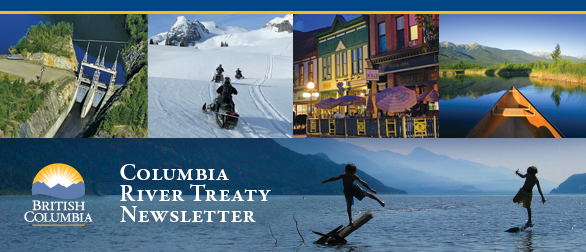Columbia River Treaty
Edition: April 2023

Integrating socio-economic interests within a modernized Treaty
Apr 5, 2023

Nakusp, B.C.
For many communities in the Columbia Basin, construction of the Columbia River Treaty dams in the 1960s and 70s had an immeasurable impact on their way of life. While the Treaty has succeeded in enabling power generation and reducing the risk of damaging floods, operation of these dams continues to affect a wide variety of interests in the Basin, including important socio-economic values like recreation, health, and economic development.
As Canada and the United States continue negotiations to modernize the Treaty, the Canadian negotiating team, which includes Canada, B.C. and the Ktunaxa, Secwepémc and Syilx Okanagan Nations, is exploring different ways of operating the Canadian Treaty dams to support domestic objectives, including for ecosystems, Indigenous cultural values, and socio-economic interests.
A computerized river management model is being used to assess different operating scenarios for dams along the Columbia and Kootenay rivers. The model shows the effects (positive and negative) that modified reservoir levels and river flows would have on a range of interests in the Basin. Indigenous Nations are leading the development of objectives for ecosystems and Indigenous cultural values that are being integrated into the modelling process, BC Hydro is developing objectives for hydropower, and the Columbia River Treaty Local Governments Committee (LGC) is spearheading an effort, with funding from the Province, to develop social and economic objectives.
On behalf of the LGC, a team of researchers and modelers has been analyzing the results of past community consultation processes to identify key socio-economic interests, raised by Basin residents, that could be affected by river flows and/or reservoir water levels managed under the Treaty.
The team also reviewed past research and met with local representatives from across the Basin to better understand the issues and desired goals for improvements, and to develop a series of associated performance measures. The performance measures define the reservoir elevations or river flows that are preferred for each interest, as well as the season in which they apply.
Thirteen performance measures have been developed to date, with at least five more in development or under consideration. Examples include:
- Recreation and tourism on the Koocanusa Reservoir
- Recreational opportunities are important both for the enjoyment of local residents, and as a driver of tourism and economic development. Yet, many types of recreation are not possible when the reservoir levels are too low or are very high with floating debris. The performance measure for this interest defines a preferred season and range in reservoir water levels for recreation and tourism.
- Flooding on Kootenay Lake
- Just over half of the inflow to Kootenay Lake is regulated by the Duncan and Libby Dams. High spring water levels can damage property or limit ferry operations. The performance measure for this interest defines the water levels needed to prevent flooding and limits to ferry operations around the lake.
- Navigation on the Kinbasket Reservoir
- Several businesses require barging access to the reservoir at various times of the year. The performance measure for this interest defines the water level required for each business, as well as the seasons that they operate in.
The LGC’s research team recently presented the full list of performance measures during two public virtual information sessions hosted by the Province on January 30 and February 2. The team answered questions and invited participants to share their feedback through an online survey to ensure the performance measures reflect local needs. To watch the recordings, visit the Information Sessions page on the B.C. Columbia River Treaty website. A summary report of these events and the feedback received will be available on the same webpage in the near future.
The LGC’s research team is in the process of considering the feedback received to determine recommendations for refining the performance measures.
Visit the CRT LGC Socio-Economic Integration webpage to learn more about this important work and to review the performance measures.


